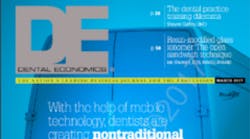Smile Lite MDP mobile dental photography tool by Smile Line USA
When communicating with a dental laboratory about shades, we are faced with several challenges. It would be nice if we could always have our ceramists spend time with our patients to develop custom shades, but that is often infeasible. Most labs charge a fee for a custom shade, which raises overhead. Plus, the logistics would preclude working with a lab that isn't close to the office. Shade tabs are obviously the traditional way to communicate shade, but most teeth don't perfectly match a single shade tab. There are often multiple shades within a single central incisor. Photography can help, but we all know that photographs can wash out color and value, and they can appear differently depending on the display. When trying to match a single central incisor, this can be a deal breaker.
Smile Line USA has developed a simple system for correcting these issues in shade communication, the Smile Lite MDP (mobile dental photography). The Smile Lite MDP uses your smartphone to send color-corrected shade photographs to your lab tech. With the previous version of this system, you would tell Smile Line USA which model of smartphone you were using, and they would send you a special case that fit your phone to align the camera with the rechargeable, color-corrected light. With the new version, any smartphone will fit, making it one size fits all.
Once your phone is in the system, it's ready to photograph. The old system needed calibration prior to each use, which required the user to put the phone case assembly in a carved-out slot within the system's storage box. Now you can skip all of that and start taking color-corrected shade photos right away.
The best thing to do is talk to your ceramist to find out what kind of photographs are preferred. When I send cases to my lab, I take a couple of shots with no shade tab. Then I do a few shots with different shade tabs that are close to matching the cervical, middle, and incisal thirds of the tooth. Finally, I snap on the polarized filter, which eliminates all glare, and take a shot with no shade tab and a shot with the closest shade tab.
The previous iteration of this system used a customized smartphone app that Smile Line USA built for the system. Now you can just take the photos using your phone's default camera app. For even better photos, you can use an app such as Camera+ on an iPhone or Pro+ with the daylight setting on a Samsung. You don't have to use a media card to transfer them to your computer or anything—just e-mail them straight to the lab, right from your phone.
The Smile Lite MDP system addresses a problem in my practice. It makes it faster and easier to communicate shade information to my laboratory. That is a challenge we all face as restorative dentists. Solo home run to center field for Smile Line USA!
SurgiTel Compact Prism 3.5x (EVK 350) and 4.5x (EVK 450) loupes
"Did you get new loupes?" my hygienist Colleen asked one day. I had gotten new loupes, but they looked similar to my last ones, so I asked how she knew. Her response floored me: "You are sitting differently." Wow! Was I? I asked which way looked more ergonomic. "With the new ones," she replied.
The new ones were SurgiTel's Compact Prism 3.5x loupes. SurgiTel's Compact Prism line features expanded-field loupes in both 3.5x and 4.5x. The expanded field allows you to see as much as possible. I was able to demo both magnifications in my practice and work with them for a couple of weeks. I liked how they are built and customized, and apparently my staff noticed how ergonomically they're designed.
SurgiTel focuses on ergonomics and ensuring that dentists stay healthy throughout their careers, in part by making sure that loupes are properly weighted and adjusted so we work with the correct head tilt. A declination angle that is too shallow increases strain on the neck, which will cause a future of neck aches, pain, and eventual herniation. These are all things we want to avoid during our careers.
The 4.5x magnification is great for restorative dentistry procedures, such as refining margins and finding canal orifices. At that high of a magnification, I did find broader procedures, such as hygiene exams, to be a little challenging, but the expanded field helped. The 3.5x magnification was nice for all procedures, but I appreciated being able to throw on the 4.5x loupes when I needed a bit more magnification. If you are in the market for new loupes, either pair would be a great choice. I would recommend basing the decision on your previous set of loupes. If you have been using 2.5x for a while, jumping to 4.5x could result in a steep curve of adjustment. However, if you have been wearing 3.5x and wouldn't mind a bump in magnification, the 4.5x with the expanded field would probably fit you very well.
SurgiTel's frame selection has always been tremendous, and it's no different for their Compact Prism line. I bought a pair of the 3.5x on an Oakley Half Jacket and they are comfortable.
I can't imagine going a day in practice without magnification. I use loupes all day, every day. I believe it is wise to invest in a pair of loupes that does its job, that is comfortable, and that is ergonomic. SurgiTel's Compact Prism line of loupes accomplishes all of that. Opposite-field double for SurgiTel!
Ionolux resin-modified glass ionomer restorative by Voco
Voco is one of my favorite dental companies because it offers reasonably priced products that provide excellent value for dentists. In past issues, I reviewed other Voco products, such as Admira Fusion and Rebilda Post. Ionolux, a resin-modified glass ionomer restorative material, is another in the long line of Voco's great offerings.
My love of glass ionomer materials has been well documented here in Pearls for Your Practice. Last month, I confessed that I ignored glass ionomers in the past, which was a detriment to my patients and me. My rediscovery of glass ionomers has opened my eyes to the array of choices on the market.
Ionolux's properties make it easy to use. With a newly designed capsule, Voco has eliminated the need for an activator, which saves a step and the need for an extra instrument in the operatory. The new capsule also has an adjustable applicator tip that is easy to angle into hard-to-reach areas. Like many other materials I use and love, Ionolux requires a triturator for mixing. If you've punted your triturator to the curb, consider investing in a new one. Triturators aren't just for amalgam anymore!
Many of the latest glass ionomer materials are chemical cured, so it's of vital importance to give them time to set fully. This takes discipline. Sometimes that means I have to leave the operatory for a few minutes so I'm not tempted to adjust prematurely. Ionolux is light cured, which means I can adjust and finish immediately after light curing—no more leaving the operatory to keep myself from jumping the gun.
Another important feature of Ionolux is its handling. It shapes and packs easily, and it won't stick to your instrument like many traditional glass ionomers will. Ionolux blends well esthetically and is available in five different shades, so you don't have to compromise on beauty. Furthermore, fluoride release is a major benefit to using glass ionomers, and Ionolux does not disappoint in that area.
Voco recommends using Ionolux for Class IIIs, Class Vs, primary teeth, provisional fillings, core buildups, and bases. This wide array of applications makes Ionolux a beneficial material to have in your cabinet. Line-drive double for Voco!












